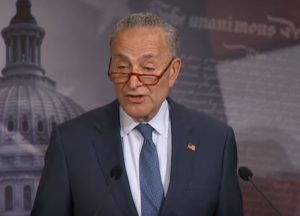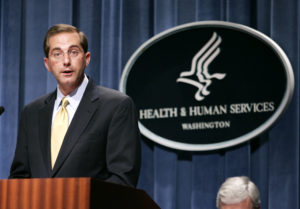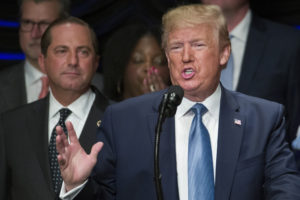TV Pitches for Prescription Drugs Will Have to Include Price
Health and Human Services Secretary Alex Azar contends that new regulations will provide "greater transparency" for American patients.WASHINGTON — TV pitches for prescription drugs will soon include the price, giving consumers more information upfront as they make medication choices at a time when new drugs can carry anxiety-inducing prices.
Health and Human Services Secretary Alex Azar said Wednesday the Trump administration has finalized regulations requiring drug companies to disclose list prices of medications costing more than $35 for a month’s supply.
“What I say to the companies is if you think the cost of your drug will scare people from buying your drugs, then lower your prices,” Azar said. “Transparency for American patients is here.”
Drug companies responded that adding prices to their commercials could unintentionally harm patients.
“We are concerned that the administration’s rule requiring list prices in direct-to-consumer television advertising could be confusing for patients and may discourage them from seeking needed medical care,” said the Pharmaceutical Research and Manufacturers of America, the main trade group.
But one major firm — Johnson & Johnson, based in New Brunswick, New Jersey — has already started disclosing the cost of its blood thinner Xarelto in TV advertising. And polls indicate many patients are not taking their medications as prescribed because of cost.
Drug pricing details are expected to appear in text toward the end of commercials, when potential side effects are disclosed. TV viewers should notice the change later this year, perhaps as early as the summer.
The government is hoping that patients armed with prices will start discussing affordability with their doctors, and gradually that will put pressure on drugmakers to keep costs of brand-name drugs in check.
Pricing disclosure was part of a multilevel blueprint President Donald Trump announced last year to try to lower prescription drug costs .
Democrats say it still won’t force drugmakers to lower what they charge, and they want Medicare to negotiate on behalf of consumers.
Leigh Purvis, a pharma expert with AARP’s research division, said disclosure will help dispel a “cloak of darkness” around prices and encourage more informed discussions between patients and their doctors. But she cautioned against expecting too much.
“The overall idea of reducing drug prices is something for which there is no silver bullet,” said Purvis. “This is just one step, one tool in what will have to be a very big arsenal.”
Other ideas from the Trump administration include regulations affecting Medicare and legislative proposals in Congress. With the cost of medicines a top concern for voters, Trump and lawmakers of both major political parties want accomplishments they can point to before the 2020 elections.
Drugmakers also complained that the price reveal will infringe on their First Amendment free speech rights by forcing them to disclose prices. It’s unclear if that will prompt a court challenge, but Azar points out that the government has for decades required carmakers to post their sticker prices on vehicles.
“Prices of automobiles are vastly less important to your health and affordability than drugs,” he said.
According to the latest government figures, the 10 most commonly advertised drugs have prices ranging from $488 to $16,938 per month or for a usual course of therapy.
The disclosure requirement will not apply to print or radio ads for the foreseeable future. It encompasses all brand name drugs covered by Medicare and Medicaid, which is nearly all.
In a twist, enforcement of the rule will rely on drug companies suing each other over violations under a longstanding federal law that governs unfair trade practices.
“There are very large legal practices built on pharma companies suing each other,” Azar said, calling it a “quite effective mechanism.”
Most people count on lower-cost generic drugs to manage their health problems, but the advent of highly effective and extremely expensive medications for once-fatal or intractable diseases has put consumers on edge. Some genetic and cellular-based treatments can cost hundreds of thousands of dollars a year, straining on the budgets of insurers and government programs.
A recent poll from the nonpartisan Kaiser Family Foundation found that 1 in 3 Americans said they haven’t taken medications as prescribed because of costs. People who take four or more medications, those who spend $100 a month or more on meds, patients in fair to poor health and middle-aged adults are more likely to report affordability problems.
Although most patients do not pay the full list prices that will be included in ads, experts say those are still important. Patient copays are often based on list prices. And many people who have high-deductible insurance plans pay list prices because their insurance doesn’t start covering until patients spend several thousand dollars of their own money.
In other economically advanced countries, governments negotiate drug prices to keep medications more affordable for patients. But the U.S. has held back from government-set prices.
Azar, who is leading Trump’s efforts on prescription drugs, is a former drug company executive. He held senior posts with Indianapolis-based insulin maker Eli Lilly and Co. after an earlier stint in government service during the George W. Bush administration.
The regulations will take effect 60 days after they’re published in the Federal Register.
Your support matters…Independent journalism is under threat and overshadowed by heavily funded mainstream media.
You can help level the playing field. Become a member.
Your tax-deductible contribution keeps us digging beneath the headlines to give you thought-provoking, investigative reporting and analysis that unearths what's really happening- without compromise.
Give today to support our courageous, independent journalists.









You need to be a supporter to comment.
There are currently no responses to this article.
Be the first to respond.